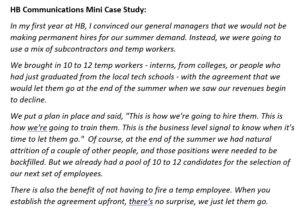Welcome back to the final installment in our blog series from Joel Harris, Understanding Variable Costs is Wildly Important for Your Integration Business.
How do you handle routine seasonal variability, peak demand, and one-time opportunities in your integration business?
Most integration businesses I work with have a hired permanent staff that they keep, whether business is up or down. With the seasonal nature of the integration business, this means you’re carrying a weight of fixed costs through periods where you have variable revenue.
You don’t have to make a permanent hire every time you have an incremental unit of work that needs to be done to satisfy your customer demand.

I find that managing your variable costs with intention requires a lot of work before you try it. I’ve seen a lot of failures where people listen to the message and say, ‘Got it, integrators should hire subcontractors, I’ll hire one at the first opportunity.’ Then that project fails, and they say, ‘Well, I’ll never do that again.’
Before integrators should hire subcontractors, there are two sets of actions that need to be completed before successfully outsourcing labor (direct or indirect).
Build your internal competency to leverage outsourced labor.
- Implement this approach as a key company-wide strategic initiative (it will not be successful if viewed as just an operations “tool”)
- Know and define your standards of performance (set expectations)
- Train your operations managers and project managers on how to manage subcontractors or temps to the standards of performance (manage to and deliver on expectations)
- Add project manager hours to manage subcontractors (compared to internal labor)
- As much as possible, transfer risk to the subcontractor by gaining fixed quotes with negotiated contractual terms for the performance of the work (if you are unable to write a scope of work that can be quoted as a fixed price, you are not prepared to use a subcontractor to increase your profitability)
- Develop internal control process for subcontractors (for example, no verbal POs, invoices must have supporting detail, responsible party must authorize payment of PO and be accountable for spend)
- Acknowledge the resistance you are going to face throughout the organization with this approach and deal with it with effective leadership (in your own company cultural style)
- Never ever blame your subcontractors for the project performance to your customers (your customers did not hire them, you did)
Build an outsourced partner network that meets your specific business objectives.
- Know which labor disciplines you can supplement with subcontractors or temps (hint: it is never your core value proposition or differentiation to the competition)
- Build a process to qualify subcontractors (and their processes and their people)
- Leverage your subcontractors for small wins before committing to them for large projects.
- Develop long term relationships so you get their best employees for your projects, not the leftovers.
- Never ever be afraid to terminate a subcontractor for poor performance. They earn the right to do the next job by their performance on this one, just as you do with your end user customer.
- Always treat your subcontractors the way you want your customers to treat you. If you simply see subs as a resource to be squeezed, nickel and dimed to death, left holding the bag for your mistakes, etc., then you will never build the type of long term relationships that make a subcontractor network successful as a long term strategic approach to enhancing profitability.
You must intentionally set yourself up for success by investing the time and resources to implement this tactical strategy.
Using truly variable costs as a replacement for fixed costs requires commitment from the entire organization to succeed. I recommend implementing this approach over time as incremental improvement rather than an “all or nothing” approach.
And finally, remember the end objective, the main reason integrators should hire subcontractors, is to increase profitability for your integration business. Then commit to that principle when making decisions to use or not use permanent hires (fixed cost labor) versus subcontractors or temps (variable cost labor).
Read the whole blog series:
Part 1 – Profits Hiding in Plain Sight
https://navigatemc.com/understanding-variable-costs/
Part 2 – A Variable Cost Structure Increases Profitability of Your Integration Business
A Variable Cost Structure Adds Profitability to Your Integration Business
Part 3 – Integrators Should Hire Subcontractors to Address Seasonality Using Labor As a Variable Cost
Join Navigate Academy!
Don’t miss the next live webinar
Friday, August 7 @ 11:00 am CDT
Project Lifecycle: Typical AV Project







